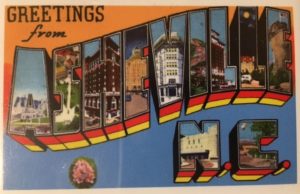[One]
WORK TRAVEL LAST FALL TOOK ME for the first time to Asheville, North Carolina, the city in the craggy, western band of the state that runs between Tennessee and South Carolina. On a cool weekday morning, I drove for 90 minutes up Highway 74 out of sprawling Charlotte, encountering the famous, smoky-blue mountain vistas as the road climbed to Asheville—weird for a native Angeleno accustomed to gazing upon the smoggy-brown San Gabriels—and arrived at my friends Virginia and Richard’s home in Arden, a woodsy suburb on the south side of town. I briefly caught up my hosts on the latest from Napa Valley, where they’d lived for years before deciding to return to their native Southeast. Then I headed out for the day to play California wine ambassador.
The agenda my friend and colleague, Gwen, had arranged for our two days together included stops at several of the more unique bars, restaurants, and retail shops I visited during all of last year. I knew before I got on the plane in Oakland that Asheville had a reputation as “Beer City, USA.” By extension, I figured there would be opportunities to sample some North Carolina chopped pig and a brown liquor concoction or two, and maybe listen to some live music (I wouldn’t be disappointed). But the level of wine appreciation I witnessed was something of a surprise, though maybe it shouldn’t have been.
Asheville is a picturesque, postcard-ready city of a little over 80,000 with a UNC campus, a minor league baseball team, and a tree-lined downtown that reminds me of the neighborhood around Shattuck and University Avenues in Berkeley. It’s perhaps most notable for its connection to the Vanderbilt family, whose scion, the imperial-sounding George II, built a chateau in the 1880s on a huge swath of land at the south end of town. He named it Biltmore Estate, an original Dutch-English moniker to honor his patrician heritage. To call Biltmore House “big” is almost comic understatement; it’s the largest single-family home in the United States, with a wide-angle façade worthy of any Loire Valley castle. Near the entrance to the estate, George 2 had a village laid out to house the workers he employed to build his mansion. Today, Biltmore Village is a section of Asheville and a charming little town-within-a-town. But before the city grew to absorb it in the early 1900s, it was a true village—a Craftsman shire, if you will, filled with Vanderbilt’s craftsmen and surrounded by misty mountains.
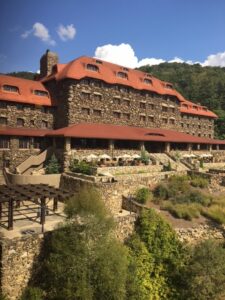 On the subject of architecture, Asheville boasts another impressive building, The Grove Park Inn. The century-old resort hotel is a historic, and aesthetically mind-altering, lodge at the edge of a south-facing hillside above the city. It appears to have been constructed from large granite boulders, chopped and roughly shaped into smaller boulders by the hands of some smoky mountain god, then laid with a curvy, red roof of molten lava. On the day of Gwen’s and my visit the inn was oddly crawling with crew-cut, Glock-toting, Men’s Wearhouse-sporting private security goons. When we pulled up to the parking facility, one of them shooed us away, his colleagues having taken up all the parking spots with their rented SUVs. Someone on an incredibly important fundraising mission (Chelsea Clinton, we’d heard, or some other Democrat genius) was being guarded by this band of wannabe mercenaries at our parking convenience expense, not to mention that of the many tourists and visitors who must have similarly been sent scurrying. There was an upshot, however: after parking offsite, we had to walk a mile of corridors and hallways through Grove Park to find the beverage guy, so I
On the subject of architecture, Asheville boasts another impressive building, The Grove Park Inn. The century-old resort hotel is a historic, and aesthetically mind-altering, lodge at the edge of a south-facing hillside above the city. It appears to have been constructed from large granite boulders, chopped and roughly shaped into smaller boulders by the hands of some smoky mountain god, then laid with a curvy, red roof of molten lava. On the day of Gwen’s and my visit the inn was oddly crawling with crew-cut, Glock-toting, Men’s Wearhouse-sporting private security goons. When we pulled up to the parking facility, one of them shooed us away, his colleagues having taken up all the parking spots with their rented SUVs. Someone on an incredibly important fundraising mission (Chelsea Clinton, we’d heard, or some other Democrat genius) was being guarded by this band of wannabe mercenaries at our parking convenience expense, not to mention that of the many tourists and visitors who must have similarly been sent scurrying. There was an upshot, however: after parking offsite, we had to walk a mile of corridors and hallways through Grove Park to find the beverage guy, so I 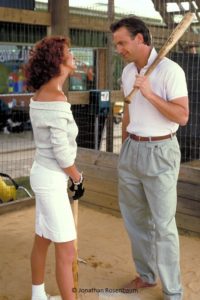 got an impromptu tour of this bad-ass Arts & Crafts palace.
got an impromptu tour of this bad-ass Arts & Crafts palace.
The first mention I can remember of Asheville was its cameo during a sequence near the end of Bull Durham, wistfully narrated by Annie Savoy (Susan Sarandon) about her baseball playing lover, Crash Davis (Kevin Costner). The minors veteran leaves her early one morning to finish his career with the Asheville Tourists. Annie laments that “Crash took off at dawn—said he heard there might be an opening for a catcher in Asheville.” He hits his minor league record-breaking homerun at McCormick Field and then—spoiler alert!—returns to Annie’s bed in Durham to listen to her recite Walt Whitman.
I’d like to think that, owing to its purported Austin-style liberalism, sophisticated roots, laid-back vibe, and presence of Deadheads and Phish followers, Asheville is not just an escape destination from the heat and humidity of the North Carolina Piedmont in warmer months, but is a progressive perch from which the land below of enduring KKK 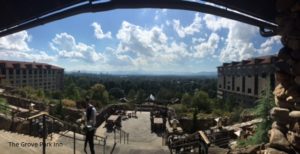 zombie-ism, Trump-enabling voter suppression tomfuckery, and the foul memory of Jesse Helms can be considered with a mix of pity and contempt. But as the Asheville wine merchant James West told me recently, “People want to be able to live their lives in peace and freedom, but what goes on behind their doors is what goes on.” So there’s that to think about, Phish fans.
zombie-ism, Trump-enabling voter suppression tomfuckery, and the foul memory of Jesse Helms can be considered with a mix of pity and contempt. But as the Asheville wine merchant James West told me recently, “People want to be able to live their lives in peace and freedom, but what goes on behind their doors is what goes on.” So there’s that to think about, Phish fans.
• • • • •
My friend Gwen is originally from Texas, but her sweetly lilting accent blends in nicely with the Asheville locals’ and those in Charlotte, where she divides her time. As wine salespeople go, she’s a bit of a bad-ass herself and could probably sell proverbial ice to Eskimos. Covering a large chunk of North Carolina in a burly Toyota, she ships Champagne to Charlotte and grüner to Greensboro. I quickly discovered that in the western outpost of her sales territory, Beer City, USA, she has a wine-centric audience for her diverse portfolio of European and West Coast products.
On the first day of my visit, a few of those folks showed up for a lunch and a tasting of the boss’s wines that Gwen had organized at Ambrozia, the neighborhood bistro chef-owner Sam Etheridge runs on the north side of Asheville. The restaurant is just down the hill from the Grove Park Inn, its name a holdover from Etheridge’s Ambrozia wine bar in New Mexico. Like a number of people I met on my visit, the chef was a transplant to North Carolina; he’d been a restaurateur in Albuquerque but was attracted to the Smoky Mountains and the prospect of relocating closer to family in his native Tennessee. Soon after sitting down to lunch and greeting our guests, I wondered if he secretly left the Southwest for lack of heavenly pork. In hog-happy North Carolina, it’s not hard or surprising to find creative restaurant charcuterie alongside traditional barbecue. Etheridge’s platter of cured and confited pig parts was a fine way to kick off the al fresco lunch while the traffic whizzed by on Merrimon Avenue.
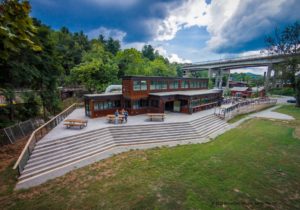 I chatted with the busy restaurateur Kristie Quinn, co-owner of a popular downtown wine bar, 5 Walnut, and the extraordinary Smoky Park Supper Club. A couple of evenings later, near the banks of the French Broad River, I would find myself seated at Smoky Park’s bar, sipping a bourbon shrub while a talented southern folk-rock duo performed on the restaurant’s exterior deck that faces the river. I was surprised to see canoes and kayaks floating past, while people strolled up and down the wide lawn that separates the supper club from the French Broad. The scene was all the more unexpected for the fact that Quinn and her partner had assembled Smoky Park from nineteen empty shipping containers a couple of years ago. The linear, ship-like footprint of the stacked and fused metal containers, arranged parallel to one of North Carolina’s beloved recreational waterways reserved for people using only paddles and oars, struck me as a clever architectural juxtaposition.
I chatted with the busy restaurateur Kristie Quinn, co-owner of a popular downtown wine bar, 5 Walnut, and the extraordinary Smoky Park Supper Club. A couple of evenings later, near the banks of the French Broad River, I would find myself seated at Smoky Park’s bar, sipping a bourbon shrub while a talented southern folk-rock duo performed on the restaurant’s exterior deck that faces the river. I was surprised to see canoes and kayaks floating past, while people strolled up and down the wide lawn that separates the supper club from the French Broad. The scene was all the more unexpected for the fact that Quinn and her partner had assembled Smoky Park from nineteen empty shipping containers a couple of years ago. The linear, ship-like footprint of the stacked and fused metal containers, arranged parallel to one of North Carolina’s beloved recreational waterways reserved for people using only paddles and oars, struck me as a clever architectural juxtaposition.

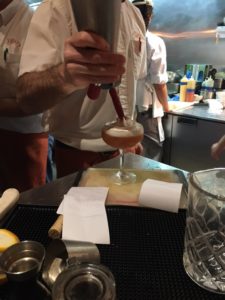
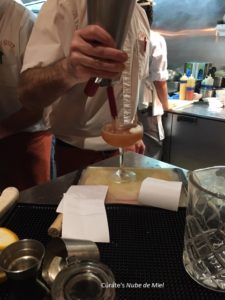 This was my second of two nights in Asheville. In between Ambrozia and Smoky Park, Gwen’s schedule
This was my second of two nights in Asheville. In between Ambrozia and Smoky Park, Gwen’s schedule 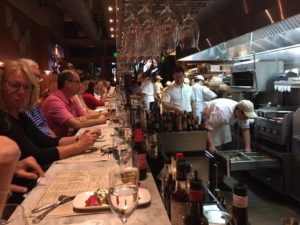 exposed me to the following: a plate of chopped pig at the nationally acclaimed Buxton Hall BBQ; a tutorial from the wine buyer at the Grand Bohemian Hotel on their fine display of Bavarian beer steins; a drive down Biltmore Avenue past McCormick Field, just after the end of the Tourists’ season; some salesman’s face time in two excellent wine shops, Table Wine in Asheville and Vaso de Vino in Arden (this was, after all, a work trip); words exchanged with a pair of quasi-menacing, though well-armed, mall cops at Grove Park Inn; a mildly harrowing ride in Gwen’s Sheridan tank Toyota to The Cliffs, a country club in the steep hills above Arden; a selection of Carolina-accented Spanish tapas and a nube de miel (“cloud of honey”) cocktail at the insanely popular restaurant Cúrate on Biltmore Avenue; and a digestif at Sovereign Remedies, described on the ornate barroom’s website as “somewhere between warm and regal” and named for Appalachia’s traditional, homegrown medicines.
exposed me to the following: a plate of chopped pig at the nationally acclaimed Buxton Hall BBQ; a tutorial from the wine buyer at the Grand Bohemian Hotel on their fine display of Bavarian beer steins; a drive down Biltmore Avenue past McCormick Field, just after the end of the Tourists’ season; some salesman’s face time in two excellent wine shops, Table Wine in Asheville and Vaso de Vino in Arden (this was, after all, a work trip); words exchanged with a pair of quasi-menacing, though well-armed, mall cops at Grove Park Inn; a mildly harrowing ride in Gwen’s Sheridan tank Toyota to The Cliffs, a country club in the steep hills above Arden; a selection of Carolina-accented Spanish tapas and a nube de miel (“cloud of honey”) cocktail at the insanely popular restaurant Cúrate on Biltmore Avenue; and a digestif at Sovereign Remedies, described on the ornate barroom’s website as “somewhere between warm and regal” and named for Appalachia’s traditional, homegrown medicines.
Unfortunately, I never made it to the Biltmore Estate, the reason many people visit the city in the first place. Though after a couple of days in Asheville, I began to sense that everywhere was Biltmore, or Biltmore was everywhere, in this city that grew prosperous around its Vanderbilts. When I listen to Talking Heads’ classic “Cities,” I think David Byrne missed an opportunity to include the estate, former stomping ground of both Vanderbilt and Cherokee, as a lyric in between Memphis (“Home of Elvis and the ancient Greeks”) and the dry ice factory in Birmingham (“A good place to get some thinking done”).
[Two]
IF I’D DONE A B.Y.O. WHEN GWEN and I stopped into Buxton Hall Barbecue for a quick lunch, the bottle of Peachy Canyon zinfandel I picked up for my hosts at James West’s eclectic shop, Westlake Wines, would have been the perfect thing to drink with pitmaster Elliott Moss’s chopped pig. No red wine, in my opinion, goes better with salty, vinegary Carolina pork than the one made from California’s favorite heritage grape, especially old-school versions like the Paso Robles winery’s. For their efforts, Moss and his team at Buxton Hall were recognized by Bon Appetit magazine as one of the top ten new American restaurants of 2016. But even in a great restaurant, day-drinking zinfandel on a weekday isn’t always an option.
When it comes to servicing Asheville’s more conventional evening-and-weekend wine drinkers, James West is there to help. Whether for a midweek bottle of malbec or something more obscure like Piedmontese pelaverga, his shop sitting just a couple of doors down from Ambrozia is slowly but surely becoming a requisite stop for customers seeking a degree of personal attention. 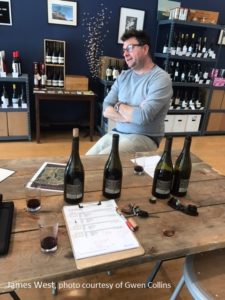
James is 44 and a Michigan native. He arrived in Asheville in the fall of 2015 from New York, where he’d done a long stint as a restaurateur. A decade ago, he and a friend researched Brooklyn neighborhoods and rents to look at opening a boutique wine shop, but the finances didn’t materialize. Instead, he focused on managing the beverages for Another Room, a low-key wine and beer bar in Tribeca where, as he described it to me on the phone recently, “you could get a five-dollar pint of beer or a seven-dollar glass of wine.” During his time there, he poured southern French standbys like Les Baux de Provence, the Cartier family’s sturdy red from Mas de Gourgonnier, their organic farm near Aix. A glass of it cost the New York bargain price of ten bucks.
If, after relocating to Asheville, James pictured opening a Brooklyn-style shop where such bargains could be had by a steady supply of neighborhood customers, the reality bite last September of his new location was a little painful. In addition to the unexpected challenge of finding someone in this artsy-crafty city to create a sign for the shop, he was no longer in a metropolis crawling with pedestrians. “In New York,” he told me, “if you open up a neighborhood wine shop, everyone is going to know about it within two or three months; it’s just a matter of keeping people coming back.” But in the new surroundings of a small Appalachian city—albeit a sophisticated, food-crazy one—he’s had to rely on slower word-of-mouth from drive-up customers and on the twin social media pillars of Facebook and Instagram to address the matter of “getting more people in the neighborhood to know about Westlake, and to stop buying their wine in grocery stores.”
• • • • •
The afternoon we met, I was sniffed and pawed by James’ dog, Moxie, who hangs out in the back of the store but likes to greet visitors. “If pressed, I say she’s a Carpathian tree hound,” he answered when I asked about Moxie’s breed. I believe I’ll eventually figure out  my wine colleague’s sense of humor, but in the meantime he indulgently—and effectively—works the Carpathian Moxie into Westlake Wines’ Instagram feed, which seems to lighten the mood and take the shop down a peg or two on the wine snobbery ladder.
my wine colleague’s sense of humor, but in the meantime he indulgently—and effectively—works the Carpathian Moxie into Westlake Wines’ Instagram feed, which seems to lighten the mood and take the shop down a peg or two on the wine snobbery ladder.
Entering Westlake, you know you’ve walked into a wine shop for all of the bottles on display, but the inventory is spread out on industrial shelves along the walls of the front room, and the rows of labels aren’t over-crowded. As James told me, “People who walk in here are really happy with the fact that it’s open. You aren’t shoved into little aisles. It’s a pretty wide open space, even though the front room is 720 square feet. I’ve tried to maximize the flow so that it’s a place where you can walk around and not feel like you’re going to bump into anything.”
In the center of the room sit a rough-hewn wood table and metal stools where he conducts tastings or offers his version of southern hospitality to friends and customers who just want to linger with a glass of wine. “The idea of what I wanted to do was find a way for my  customers to actually want to hang out here,” he said. I expect as his business grows, so will the selection of bottles, but for now he’s running lean, mean, and purposefully eclectic.
customers to actually want to hang out here,” he said. I expect as his business grows, so will the selection of bottles, but for now he’s running lean, mean, and purposefully eclectic.
“The one good thing about trying to keep my inventory under 250 bottles is that I’ve had everything in here. I can be asked about a bottle and do actually remember what it tastes like, even though it was six months ago when I first drank it. I’m going to remember everything that’s in here, and I’ll be able to describe it to people. For me, I’ve got to try everything.”
That would include pelaverga, the pale red, strawberry-ish grape variety from Italy’s Barolo zone. It makes a delightfully obscure wine that is right up James’ alley as a retailer in a city where people do things a little differently. As he put it, “Here in Asheville, you have to have a broader reach, so I’m trying to seek out those wines that people may not know.”
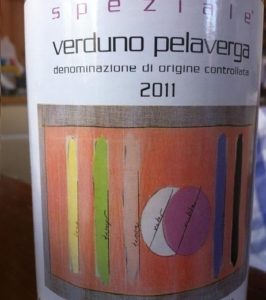 We talked about the wine grape I’ve tasted only once or twice in my life. “Pelaverga is from a very small parcel of vineyards in Piedmont. It’s very briar patch, strawberry-esque, and very light. But not pinot noir-like or gamay-like. It’s sort of in the middle, and I thought it was really interesting.”
We talked about the wine grape I’ve tasted only once or twice in my life. “Pelaverga is from a very small parcel of vineyards in Piedmont. It’s very briar patch, strawberry-esque, and very light. But not pinot noir-like or gamay-like. It’s sort of in the middle, and I thought it was really interesting.”
“It wasn’t surprising that I hadn’t heard of it, and it was certainly different and unique,” he added, recounting the meeting when an Italian wine specialist brought a sample for him to taste after canvassing his varied inventory. “But it was almost a random thing.”
This “random thing,” pelaverga, is in fact a good example of what James is trying to pull off at Westlake: to leave no stone unturned in his search for wines that make an impression on him and which he can, in turn, recommend to his customers to adjust their expectations of what “good” wine is all about. “With my selections, I don’t know if you’re going to like this or that wine as much as I do, because I don’t know specifically what your tastes are, especially when it’s the first time or the second time you’re walking in. My goal is to just make sure that every single wine in here is invariably interesting. You know, it’s got to be interesting. It’s got to be different.”
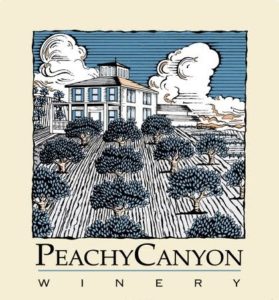 I thought back to James’ recommendation of the Peachy Canyon zinfandel and reminded him of it when we spoke. He acknowledged that he has his share of customers who are heading home to dinner “and need something quick and easy like a bottle of malbec.” Or, in my case, something dependable to remind my hosts of the Golden State they’d left behind. “But at the same time,” he said, “I’d much rather spend 15 or 20 minutes with the person and try to get them to pick up something that they may not know, or rediscover something—German riesling, maybe—that they had 15 years ago and didn’t like.”
I thought back to James’ recommendation of the Peachy Canyon zinfandel and reminded him of it when we spoke. He acknowledged that he has his share of customers who are heading home to dinner “and need something quick and easy like a bottle of malbec.” Or, in my case, something dependable to remind my hosts of the Golden State they’d left behind. “But at the same time,” he said, “I’d much rather spend 15 or 20 minutes with the person and try to get them to pick up something that they may not know, or rediscover something—German riesling, maybe—that they had 15 years ago and didn’t like.”
When you’re an adventurous wine drinker who puts yourself in the hands of a wine merchant whose taste runs to both Paso Robles and Piedmont, and from there to Dalmatian plavac, Swartland syrah, Valencian bobal, and Redwood Valley valdiguié, i.e. all over the wine map, receiving favorable advice on a more straightforward bottle of zinfandel can inspire confidence by association. But as James mentioned more than once during our phone call, “Everything in this shop is a hand-sell.”
[End of part one]
